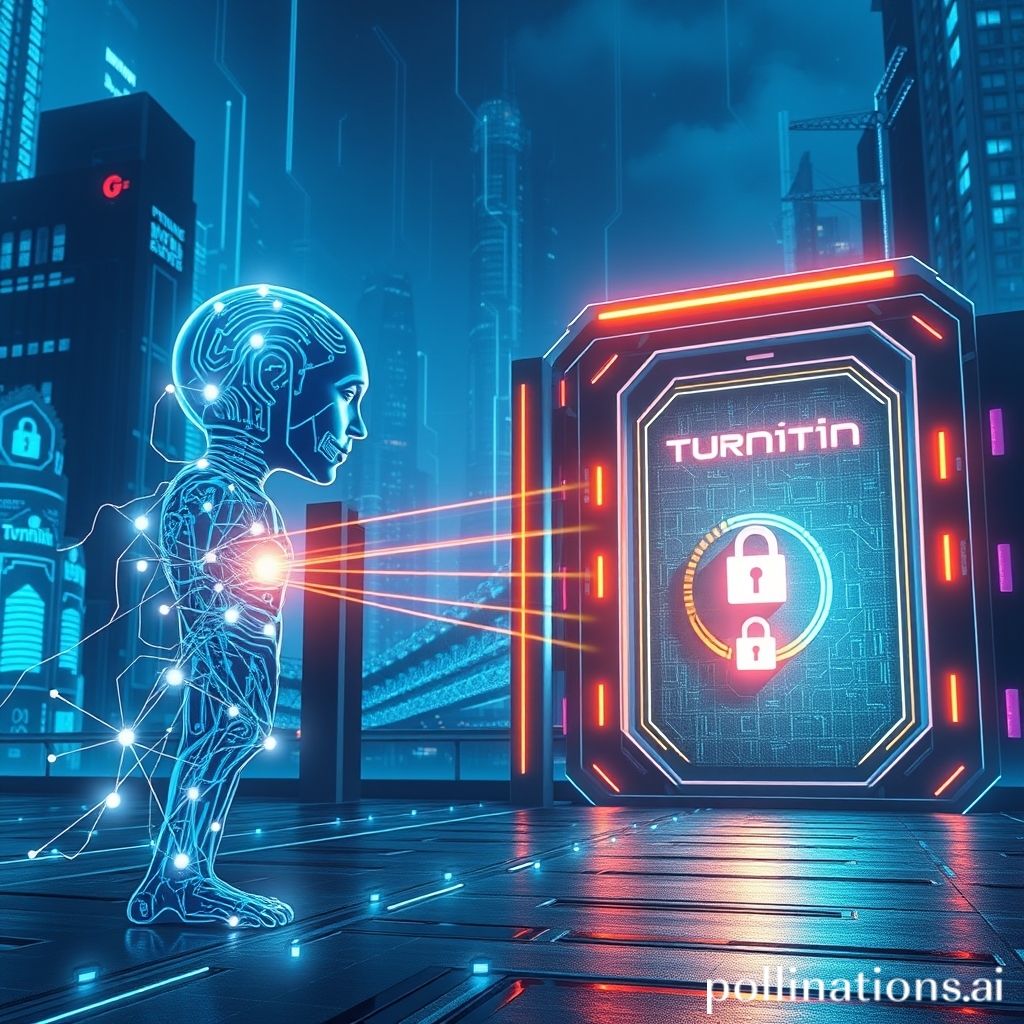Table of Contents
- Introduction
- Introduction to Turnitin and its role in plagiarism detection
- Understanding the capabilities of AI in writing
- How Turnitin detects AI writing
- Limitations and challenges in detecting AI writing
- The future of AI in academic integrity and plagiarism detection
- Conclusion
- Frequently Asked Questions
Introduction
Imagine a world where robots write essays, articles, and even books, without any human intervention. It may sound like science fiction, but with the rapid advancements in artificial intelligence (AI), this is becoming more and more of a reality. However, this emerging technology poses a fundamental question – can automated writing be detected?
With the rise of AI-powered writing tools like Turnitin, which uses machine learning algorithms to check for plagiarism and produce original content, the battle between human and machine-written content is intensifying. Are these AI-powered tools the ultimate solution to academic dishonesty, or do they have limitations? To answer these questions, we delve into the intriguing world of AI and Turnitin, and explore whether it is possible to distinguish between automated and human-generated content.
Join us on this captivating journey as we uncover the secrets behind AI-driven writing and the challenges it presents. Discover the methods used to detect automated writing and the potential consequences for academia and the writing industry. Get ready to dive into the fascinating debate of AI vs. Turnitin and explore the future of writing in this AI-dominated era.
Introduction to Turnitin and its role in plagiarism detection
Imagine this: you’re a student, typing away on your essay late at night, and suddenly a chill runs down your spine. Can Turnitin, the ultimate plagiarism detection tool, sniff out your AI-generated masterpiece?
Well, let’s dive into the digital domain of Turnitin and see what wizardry it possesses. Turnitin, my friends, is a heavyweight champion in the arena of plagiarism detection. It’s the Sherlock Holmes of academic honesty, the Hound of Baskerville for plagiarists.
Picture Turnitin as a vigilant librarian with a discerning eye. It scans your document like a hawk, hunting for any suspiciously familiar phrases, paragraphs, or even whole essays. And let me tell you, this clever software doesn’t just rely on hard evidence; it’s got a keen nose for the subtle scent of deception.
Now, you might be thinking, ‘Can’t I just go all Sneaky Steve and shuffle the words around to throw off Turnitin?’ Well, my friend, here’s the irony: Turnitin isn’t fooled by shuffling words like a deck of cards. It’s equipped with the power of context and analysis, able to detect patterns and similarities that a mere human eye may overlook.
But let’s address the elephant in the room: AI-generated writing. Can Turnitin expose essays composed by the genius algorithms of artificial intelligence? This question lingers in the minds of both students and educators, like the suspense before a plot twist in a gripping novel.
Understanding the capabilities of AI in writing
So, you’re sitting there, wondering if Turnitin can sniff out the AI writing you’ve been dabbling in. Well, my friend, let’s dive into this intriguing topic and shed some light on the capabilities of AI in the realm of writing.
Now, here’s the lowdown: Turnitin, the infamous plagiarism detector, sure has its tricks up its digital sleeve. It’s been designed to catch those copycats who think they can get away with stolen words. But can it truly detect the subtle nuances of AI-generated content? That’s the real question.
Picture this: you’ve crafted an AI writer that churns out beautifully written pieces, rich in metaphorical marvels and vivid imagery. With cunning precision, your AI companion crafts articles that even make Hemingway raise an eyebrow in admiration. But alas, does Turnitin possess the cunning to unmask your AI’s talent?
You see, AI writing is like a chameleon, blending into the fabric of human language. It can mimic literary devices that tickle our imagination, evoking emotions like a master storyteller. The irony lies in the fact that Turnitin may have a hard time distinguishing between genuine human expression and the intricacies of AI-generated prose.
However, we mustn’t dismiss our vigilant friend entirely. Like a bloodhound on the trail, Turnitin keeps evolving. Its developers work tirelessly to refine its algorithms and sniff out the cleverest of AI tactics. It’s a never-ending chase, my friend, between writers and the watchful eyes of technology.
How Turnitin detects AI writing
Alright folks, let’s dive into the fascinating world of Turnitin and how it handles this intriguing question: Can it actually detect AI writing? You might be thinking, ‘Oh, come on, can a machine really catch another machine?’ Well, prepare to have your mind blown!
Turnitin uses some fancy algorithms and technology to sniff out those sneaky AI-written papers. It’s like a detective hunting down clues! Just think of it as Sherlock Holmes for your essays. You see, Turnitin has a massive database filled with millions of papers from various sources. It has seen it all, from brilliant papers to not-so-brilliant ones.
When you submit your work, Turnitin gets to work behind the scenes. It compares your paper to its vast database, looking for similarities, patterns, and even subtle hints that might give away the involvement of artificial intelligence. It’s like a bloodhound picking up a scent!
But wait, there’s more! Turnitin also analyzes the language, style, and composition of the paper. It’s like a literary expert examining the subtle nuances and quirks of your writing. It can detect if the words flow a little too smoothly, or if certain phrases seem out of place.
So, my friends, while AI writing might seem like the next big thing, Turnitin is here to keep it in check. It’s the watchful guardian, the gatekeeper of academic integrity. And hey, it’s a reminder that creativity and originality still go a long way in crafting a remarkable piece of work!
Limitations and challenges in detecting AI writing
Alrighty then, let’s talk about the limitations and challenges when it comes to detecting AI writing! Now, buckle up because we’re diving into some tricky territory. You see, Turnitin, the popular plagiarism detection tool, has its work cut out when it encounters AI-generated content.
It’s like trying to catch a sly fox in a game of hide-and-seek. AI writing can be as smooth as butter, slipping through the cracks and leaving the human eye none the wiser. Talk about a cat and mouse game! The incredible capabilities of AI have made it quite the formidable opponent for plagiarism detection software.
Now, imagine this scenario: you’re a teacher, diligently grading a stack of papers. Suddenly, you come across an essay that stirs your suspicions. Is it a student’s work or the cunning creation of an AI-powered ghostwriter?
Here’s the deal. AI has the power to mimic human writing styles, imitating syntax and grammar like a chameleon blending into its surroundings. It’s like magic, but with lines of code! Turnitin and similar tools may struggle to differentiate between authentic student writing and AI-generated content.
But hey, don’t lose all hope just yet! Just like Sherlock Holmes never gives up on solving a case, technology keeps evolving to keep up with the sneaky AI. So, the game of cat and mouse continues, with researchers and developers working hard to enhance plagiarism detection methods and stay one step ahead of the AI writing revolution.
The future of AI in academic integrity and plagiarism detection
Picture this: you’re a student, burning the midnight oil to complete your essay. The deadline looms like a dark cloud, and you’re tempted to take a shortcut. Enter AI writing, a futuristic tool that seems like a godsend.
But hold your horses! Can Turnitin, the academic integrity watchdog, sniff out AI-generated content?
The future of AI in academic integrity and plagiarism detection is a hot topic. It’s like a game of cat and mouse—a constant dance between technology and cheating. Just when students think they’re one step ahead, plagiarism detection tools like Turnitin evolve.
Students may assume that AI-generated essays pass the plagiarism test, but the reality may be a bitter pill to swallow. Turnitin, with its sophisticated algorithms, is no slouch. It can spot the subtlest of deviations, like a bloodhound on the scent.
Picture this: you submit your AI-written masterpiece, confident it’ll slip under the radar. But then, Turnitin strikes with a resounding blow. Irony gnaws at you—AI that seemed invincible becomes your downfall.
The future holds promise and challenges. While AI aids in identifying plagiarism, it also presents new methods for students to game the system. The battleground of academic integrity continues to evolve, and it’s up to institutions and technology to keep up.
Conclusion
In conclusion, the article highlights the ongoing battle between AI-generated writing and plagiarism detection tools like Turnitin. While Turnitin has proven to be a formidable opponent, capable of detecting patterns and indicators of AI writing, it also faces limitations and challenges in keeping up with the ever-evolving AI technologies.
However, it is essential for students and educators to stay aware of the importance of academic integrity and the risks associated with using AI-generated content. Utilizing tools like WPHorde can provide an extra layer of protection against plagiarism, ensuring that originality and creativity remain at the core of academic work.
By utilizing WPHorde, students can have peace of mind knowing that their work is authentic and free of AI-generated content. It is a powerful tool that helps maintain academic integrity and supports students in creating remarkable pieces of work.
Don’t get left behind in the battle against AI-generated writing. Take control of your academic integrity by using WPHorde and ensure that your work stands out as the product of your own original ideas and efforts.
Get started with WPHorde today

